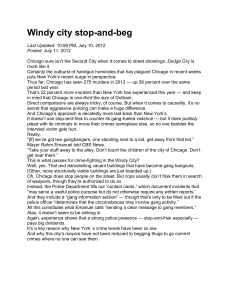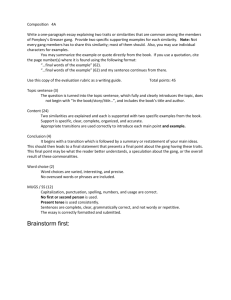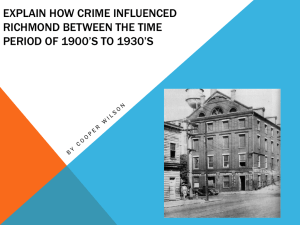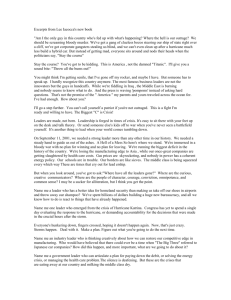Gangleader for a Day
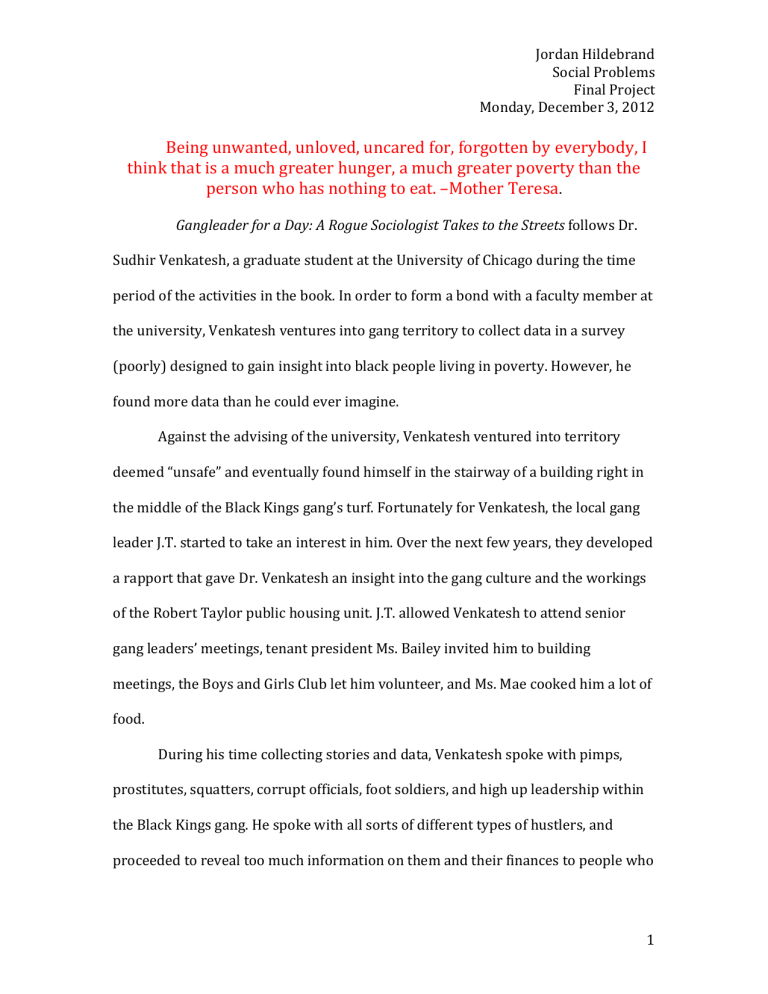
Jordan Hildebrand
Social Problems
Final Project
Monday, December 3, 2012
Being unwanted, unloved, uncared for, forgotten by everybody, I think that is a much greater hunger, a much greater poverty than the person who has nothing to eat. –Mother Teresa
.
Gangleader for a Day: A Rogue Sociologist Takes to the Streets follows Dr.
Sudhir Venkatesh, a graduate student at the University of Chicago during the time period of the activities in the book. In order to form a bond with a faculty member at the university, Venkatesh ventures into gang territory to collect data in a survey
(poorly) designed to gain insight into black people living in poverty. However, he found more data than he could ever imagine.
Against the advising of the university, Venkatesh ventured into territory deemed “unsafe” and eventually found himself in the stairway of a building right in the middle of the Black Kings gang’s turf. Fortunately for Venkatesh, the local gang leader J.T. started to take an interest in him. Over the next few years, they developed a rapport that gave Dr. Venkatesh an insight into the gang culture and the workings of the Robert Taylor public housing unit. J.T. allowed Venkatesh to attend senior gang leaders’ meetings, tenant president Ms. Bailey invited him to building meetings, the Boys and Girls Club let him volunteer, and Ms. Mae cooked him a lot of food.
During his time collecting stories and data, Venkatesh spoke with pimps, prostitutes, squatters, corrupt officials, foot soldiers, and high up leadership within the Black Kings gang. He spoke with all sorts of different types of hustlers, and proceeded to reveal too much information on them and their finances to people who
1
Jordan Hildebrand
Social Problems
Final Project
Monday, December 3, 2012 used and abused it. He helped to write grants to aid in programs for the underprivileged youth that he grew to know and love. He gained access to the Black
Kings accounting records, the most detailed of any gang records up to that point. He incurred his car being broken into, survived several drive by shootings, and even more importantly came out alive from speaking with the leaders of a gang known for violence. Even his main connection had violent streaks in from of him.
Without a doubt, this is the saddest book I have ever read. Growing up in a rural Kansas town, I have seen my fair share of poverty. I wish I could say it’s due to the one on one interaction and better education at small schools that are the big draw to towns like mine, but it’s not. My hometown is bombarded by people who are attracted to the lower living costs and sometimes because of the complacent police force and access to drugs. Even I, as the town goody-‐two-‐shoes, know the drug houses in town. But, from my perspective of this book, things get a little different when nearly every home is a drug house.
Funnily enough, when I was a sophomore in high school, I went to a Students
Against Drunk Driving conference with ten of my fellow classmates in order to explore interest in starting our own chapter of the organization. During the conference, we had a break out session in which we had a member of the Norwich chapter met with the Stafford kids in order to create a game plan. After about ten minutes of uncomfortably talking with the member, she asked us what we felt were the biggest problems in our town. We replied with the usual underage drinking and
2
Jordan Hildebrand
Social Problems
Final Project
Monday, December 3, 2012 drug usage. She prodded us for more issues, and we could think of only a few more, and still, she seemed unsatisfied. She finally blurted out, “What about the gangs?”
After a few seconds of awkward silence followed by laughter, we all realized that it was a serious question. She told us that her advisor had warned them specifically about our school, because from what she had heard, we had serious gang issues in our town of less than 1,000 people.
This is, fortunately, was the closest I have ever run into gang activity. I was blessed to be born into both my family and community, even with the issues that they both may have. But, there are millions of people who are born into situations like Sudhir Venkatesh experienced. One thing that really stuck out to me was the, albeit dysfunctional, sense of community, Dorothy and her “Stick Together Gang”, for example. Even after living in essentially inhumane conditions, these women found ways to rely upon themselves even in the direst of situations. This aspect reminds me a lot of my own hometown’s sense of community. There are older members of the community who essentially adopt entire families and help them to get back onto their feet, a constantly filled food bank at the Methodist Church and benefit dinners almost every week for a member of the community.
The surprising aspect to me is that J.T., the local gang leader, claims that his gang is a “community organization”. While the mainstream says that the drug trafficking is dangerous and that its takes money away from the poor people who live in that community, J.T. argued that it instead took the most money from the useless drifters in the community and helped to support the income of everyone
3
Jordan Hildebrand
Social Problems
Final Project
Monday, December 3, 2012 else. In addition, the gangs give thousands of dollars to youth programs and require that all gang members have received their high school diploma.
During a two week long Chicago teacher strike, the Black Kings and the Boys and Girls Club helped to sponsor what was supposed to be an informal school for the gang members in Robert Taylor. Unfortunately, it looks like when you get twenty-‐fifty young gangsters in a room, it’s not a particularly conducive learning environment.
However, J.T. never elaborated on the dangers of the gang life in the book. T.
Bone, one of J.T.’s senior officers, longed to get out of the gang life and start his own business. T. Bone knew that the industry was dangerous and would eventually lead to imprisonment or death. Unfortunately for T. Bone, both of those eventualities came true. During the Venkatesh’s time in the projects, he survived at least three drive-‐by shootings. Corrupt police officers raided apartments for money and anything else of value and routinely beat people. Violence plagued the street and domestic violence plagued apartments. Many of these issues can be directly traced back to the gang’s activity in the area, and I think disproves J.T.’s claim of being a community organization.
After reading about the disruption in Venkatesh’s “classroom”, I grew curious to see just how well Chicago’s school districts do in national testing. According to
2011 results from The Nation’s Report Card, Chicago scored four points lower (270) than the national urban school district average (274) in mathematics during the 8 th grade. This is 13 points less than the national public school average (283). However,
4
Jordan Hildebrand
Social Problems
Final Project
Monday, December 3, 2012 this is a vast improvement from 2003 when Chicago 8 th graders only scored 254 points. This trend was also seen in the newest available reading (253 Chicago score,
255 urban average score) and science (121 Chicago score, 134 urban average score) scores for 8 th graders. However Chicago 8 th graders’ 2007 average scores in writing
(146) were slightly higher than the urban average score of 145.
Another part of the book that caught my eye was after Clarisse stumbled into
Ms. Bailey’s apartment. Venkatesh took her back to her apartment and she told him that Ms. Bailey wouldn’t give them food. In order to make sure that Clarisse’s children had food, he took them to a “grocery store”.
“When I told Clarisse’s girls that we were going to fill up a shopping cart, they looked like I’d just given them free passes to Disney World. While they grabbed candy, I tried to sneak in a few cans of spaghetti-‐alas, one of the most nutritious items on the shelves-‐ and some milk, cereal, and frozen dinners.”
After being actively involved in the FFA, working with Hunger U, heading up SWIPE Out Hunger and being an agriculture major, I have heard all about “food deserts”. Food deserts are, as defined by the Centers for Disease Control and
Prevention, areas that lack access to affordable fruits, vegetables, whole grains, low fat milk and other foods that make up the full range of a healthy diet. As much as I had memorized statistics on food deserts, I had never thought about the implications of them. That is until I pictured two young girls piling candy into a dingy shopping cart in a crowded, dirty grocery store as a young Indian man threw various cans in under the piles of candy.
5
Jordan Hildebrand
Social Problems
Final Project
Monday, December 3, 2012
Most people think of the United States an entirely food secure country, but this is simply not the case. Again, I decided that I wanted to follow up on this realization with some research. According to the USDA, the area that the Robert
Taylor Homes were once located in is now food secure. But, that was expected since
Venkatesh said that the area was now middle class condos after the last building was demolished in 2007. But scattered around the area are small areas where food is still scarce. A little southeast of the former Taylor homes there are three clustered zones with 100 percent of people having low access to safe, nutritious food. That small area accounts for 4,243 people, which is over four times the amount of people in my hometown. This is astonishing. Go a bit further south and there are massive chunks of area where food is scarce. This is right in the middle of a bustling, metropolitan area, and we are failing to feed tens of thousands of people.
But as shocking as that realization was, I decided to do some investigating in my own backyard. After typing in my hometown, I learned that it is right in the middle of a massive food desert. Although I don’t understand how many hometown city limits are included, (we have a local grocery store that carries a lot of fresh fruits and vegetables, some of which are locally grown) I do understand how the remote homes in the county would be considered for this unwelcome category. It’s thirty miles to the nearest Walmart from my town’s outskirts, so the people in more rural areas may have harder access to those grocery stores.
Another important aspect of the story line was the drug culture. From what I understand from the book, customers had easy access to drugs in the Robert
6
Jordan Hildebrand
Social Problems
Final Project
Monday, December 3, 2012
Taylor Homes area. It was also convenient for people in other areas of Chicago to get to because of it’s close location to a major Chicago traffic artery and popular because of the lack of police intervention in the area. Once customers arrived, they could just pull up and have either roadside service or head near an apartment building to find a dealer. Products ranged from marijuana to crack, with the Black Kings main focus being crack.
In contrast, despite my naivety in the Manhattan drug market, many people at K-‐State have experience in these areas. One popular illegal drug when taken without a prescription is Adderall. Apparently I don’t look like I struggle enough in Hale Library, because dealers approach students to see if they want pills to study with.
Another popular drug in the Manhattan area is marijuana. According to an anonymous source, the first interactions are usually done through friends and their friend’s “person”, unless you know a dealer personally. From there, the dealer will usually make a house call where you walk up to the vehicle and pay for it or they will ask to meet somewhere remote. Another anonymous source said that her ex-‐ boyfriend back in California used to do drugs and would support his usage and income by dealing as well. In order to keep the heat off of himself, he would ask her to deal, too. She would make house calls and even enter into people’s apartments in order to collect money.
Another main staple of the Black Kings operation was prostitution. One of the central women in the book, Clarisse, was a prostitute. She claimed to only do it
7
Jordan Hildebrand
Social Problems
Final Project
Monday, December 3, 2012 when she needed money to feed her kids and that she didn’t hustle for drugs. This was disproven when she wandered into Ms. Bailey’s apartment drunk or high as a kite. One would not think of the sleepy Little Apple, as having issues with prostitution, but that, too, is false. Just two years ago, a prostitution ring was busted in Manhattan and one of the main customers was an RA in the dorms on campus.
This was eye opening for many students and parents at K-‐State.
I believe Venkatesh’s main objective when he first started to experience this was to win favor with his advisors. His father encouraged him to do so in order to gain opportunities both during and post graduate school. But soon, this project developed into his thesis and ultimately became an area of personal investment
(which has positive and negative impacts). I think he wrote Gang Leader for a Day in order to bring attention to the issues found in impoverished areas scattered
throughout the United States. And he did so.
As demonstrated by the early parts of this paper, it garnered enough attention in my mind for me to do actual research and compare it to what I know. I have never been in a real “ghetto”. The largest city I have been in was Washington
D.C., but our school tour guides weren’t chomping at the bit to take us into these
“dangerous” areas. Doing the research also opened my eyes to problems in my own backyard. I always knew that I grew up in a rural area that was plagued by poverty, but I didn’t realize how bad it was until I researched it.
It makes me feel like I have failed my own people. To not recognize their true disparity when I see it all the time. But the fact that there are thousands of people in
8
Jordan Hildebrand
Social Problems
Final Project
Monday, December 3, 2012 areas where literally millions of people pass through everyday astounds me. I can’t imagine that many people in an area, let alone that many people not doing anything to help their neighbors just a few blocks away.
The author’s literal first question was, “How does it feel to be black and poor?”
But fortunately, his interest soon developed further into the workings of the Robert
Taylor Homes, the gang culture that thrived within the area and the survival of the tenants. He found that the public housing survived on extortion, bribery, and tenants’ feelings of community and gang muscle. Throughout the years that he spent nearly everyday in the projects, he talked to countless people in order to find out how they lived. People survived by any means possible, from selling candy to selling their bodies. He immersed himself into the culture of the projects and the only things that were off limits were items that he could be in trouble with the law for knowing.
To be honest, the only reason that I chose this book is because it was the only one that I could buy on my Kindle. I wasn’t expecting to enjoy it at all, but when I started to read it, I had trouble putting it down. I didn’t necessarily like the style that it was written in sometimes, but the content was incredible. I knew that poverty was a major issue in metropolitan areas, but I had no clue how they survived. Who knew that some squatters helped residents fix appliances and get free electricity and gas and, more importantly, where could I get one to help me out?
I typically don’t even like to read non-‐fiction books, but this was an exception.
I think it’s because I may not have had experience with metropolitan poverty, but I
9
Jordan Hildebrand
Social Problems
Final Project
Monday, December 3, 2012 do have the experience with poverty in my own community. Although the root problem is the same, people survive in different ways. In my hometown, the school system and the churches are vital parts in helping impoverished people. In Robert
Taylor, however, it seems like they rely on their literal neighbors very heavily. In addition, they also barter with anything they have. People exchange child care for food and do other crafty things just to get by.
When the Robert Taylor Homes were built, they were supposed to be a beacon of hope for the poor people who would inhabit them. Soon enough, this hope was squashed when corruption and violence began to take over the area.
Supposedly the predominately African American gangs of Chicago were based on the improvement of the community through civil rights movements and lobbying for tenant rights. However, soon enough the “gang” format started to be used for financial gain through hustling, drugs, and prostitution. So the basis of these violent gangs truly do have roots in the past, and will most likely continue to flourish in the foreseeable future. The former tenants of Robert Taylor would argue that their impoverishment was rooted in the oppression of the African American race. It’s widely accepted in public housing that the reason why these housing units exist is to segregate races.
I would be interested to see where all the residents of Robert Taylor Houses moved. Venkatesh mentioned where some of the residents ended up, but to see a statistical analysis of where the residents moved. All in all, this was a fascinating book. To know that there are huge social problems like this in our own American
10
Jordan Hildebrand
Social Problems
Final Project
Monday, December 3, 2012 backyard is truly disturbing. I believe that Dr. Venkatesh wrote this book, continues his studies and shares his knowledge with students in order to change the status quo in regards to poverty. Americans have grown complacent in the fight against poverty in their own nation, and I think sharing Venkatesh’s story can inspire action to save communities and lives.
11
Works Cited:
Jordan Hildebrand
Social Problems
Final Project
Monday, December 3, 2012
"USDA ERS -‐ Go to the Locator." USDA ERS -‐ Go to the Locator. USDA, 23 Aug. 2012.
Web. 02 Dec. 2012. <http://www.ers.usda.gov/data-‐products/food-‐desert-‐ locator/go-‐to-‐the-‐locator.aspx>.
"Trial Urban District Assessment." NAEP -‐. U.S. Department of Education, n.d. Web.
02 Dec. 2012. <http://nationsreportcard.gov/tuda.asp>.
Venkatesh, Sudhir. Gang Leader for a Day: A Rogue Sociologist Takes to the Streets .
New York: Penguin Press, 2008. Kindle file.
"A Look Inside Food Deserts." Centers for Disease Control and Prevention. Centers for Disease Control and Prevention, 24 Sept. 2012. Web. 02 Dec. 2012.
<http://www.cdc.gov/features/fooddeserts/>.
12

